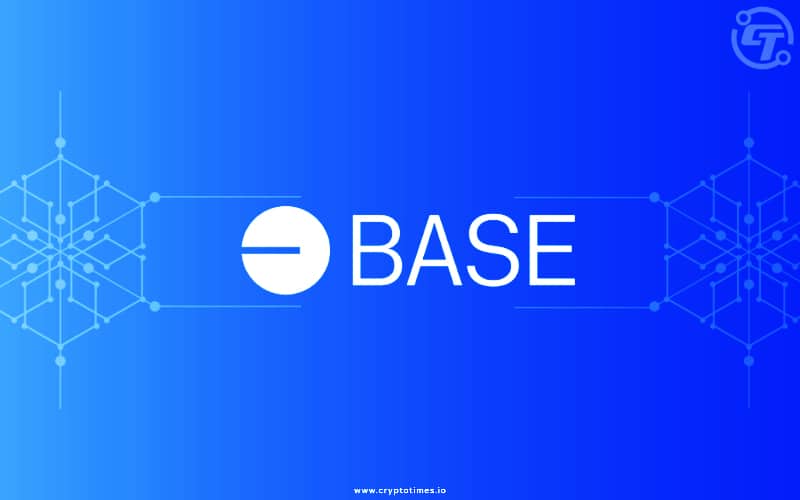Cryptocurrency has revolutionized the financial landscape, but its growth has brought new challenges. Though blockchain technology has its limitations, ongoing developments such as protocol upgrades, rollups to enhance scalability, cross-chain compatibility, etc. push for greater DeFi adoption.
To set itself at the forefront of innovation, Coinbase unveiled its decentralized plans for Base Chain, a groundbreaking innovation set to redefine how we view blockchain technology and its possibilities.
Jesse Pollak, who is overseeing Base as Coinbase’s head of protocols, said “Historically, the aperture of what people can do with crypto has been relatively limited, mostly speculation”.
Pollak explained, “In order for Coinbase and crypto and this work that we’re doing to have the impact that we all want, we need to move from the place where this is speculation to a place where this is integrated into every part of someone’s day-to-day existence.”
In this article, we will delve deep into the world of Coinbase’s Base Chain, exploring its significance and potential in shaping the future of cryptocurrencies.
Chapter 1: The Genesis of Coinbase Base Chain
Coinbase, a household name in cryptocurrency trading, ventured beyond its conventional boundaries to create Base Chain. This isn’t just a new addition to the crypto arena; it’s a paradigm shift in how we interact with blockchain technology.
Coinbase’s Base Chain, at its essence, is the Ethereum layer-2 blockchain infrastructure that facilitates seamless and secure communication between various blockchains. Think of it as the “Internet of Blockchains,” acting as a bridge that connects different cryptocurrencies, allowing them to interact seamlessly.
Chapter 2: Deciphering the Fundamentals
Before we dive deeper into Coinbase’s Base Chain and its capabilities, let’s break down the core elements that establish its presence felt in a DeFi niche:
2.1 Interoperability
The ability to communicate and share information between different blockchains seamlessly is the Base Chain’s defining feature.
Traditional cryptocurrencies have existed in silos, making the process of asset or data transfer cumbersome. Base Chain eliminates these barriers, ushering in a world where various cryptocurrencies can interact and share data securely.
2.2 Cross-Chain Compatibility
Perhaps the most compelling aspect of Base Chain is its cross-chain compatibility. It acts as a universal translator, enabling various blockchains to speak the same language.
This interoperability opens up endless possibilities for developers and businesses looking to leverage multiple blockchains simultaneously.
Chapter 3: Revolutionizing DeFi and NFTs
Decentralized Finance (DeFi) and Non-Fungible Tokens (NFTs) have been the talk of the town in the cryptocurrency world. Coinbase’s Base Chain has the potential to elevate both of these trends to new heights.
3.1 DeFi Enhancement
By connecting different blockchain networks, Base Chain creates a more robust and versatile DeFi ecosystem. Users gain access to a broader range of financial services, all while enjoying the benefits of cross-chain compatibility. The possibilities for DeFi innovation are endless, from lending and borrowing to yield farming and asset management.
Interestingly, the SEC has recently warned against many DeFi platforms. The agency has announced its intention to take action against crypto exchanges and DeFi projects that it believes are breaking the rules regarding securities, just like it did with Coinbase Inc. and Binance.
Also Read: Binance & Coinbase Under Fire: Is the SEC Killing Crypto?
3.2 NFT Transformation
Coinbase’s Base Chain also simplifies cross-chain NFT trading. Artists and collectors can now exchange digital assets seamlessly across various platforms, expanding their reach and opportunities. This newfound liquidity and accessibility could redefine the NFT market, making it more vibrant and inclusive.
Chapter 4: Real-World Applications
As we explore the depths of Base Chain’s capabilities, it’s crucial to understand its practical applications across various industries. This section will shed light on how this innovative blockchain infrastructure is poised to make a real impact.
4.1 Finance and Banking
Coinbase’s Base Chain has the potential to reshape the entire financial sector. With its enhanced scalability and interoperability, it can streamline cross-border payments, reducing transaction times and costs significantly. This innovation can also facilitate the creation of new financial products and services, such as multi-chain asset management and cross-chain lending.
4.2 Supply Chain Management
In the realm of supply chain management, transparency and traceability are paramount. Base Chain’s security features and data-sharing capabilities can be harnessed to create a more transparent and efficient supply chain network. This would enable consumers to trace the origin and journey of products, ensuring authenticity and ethical sourcing.
4.3 Healthcare
Healthcare is another sector that can benefit from Base Chain’s capabilities. The blockchain infrastructure can securely store and share patient data across healthcare providers, ensuring the integrity and privacy of medical records. Additionally, it can streamline insurance claim processing, thereby reducing administrative overhead.
4.4 Gaming
The gaming industry has already embraced blockchain technology, and Base Chain can take it to the next level. By enabling cross-chain item trading and enhancing the security of in-game assets, gamers can have greater control and ownership of their virtual items. Furthermore, the technology can enhance the multiplayer gaming experience, reducing latency and improving gameplay.
Also Read: Top 10 GameFi Projects for Making Money
4.5 Government and Governance
Governments can leverage Coinbase’s Base Chain to enhance transparency in elections and voting processes. The immutability of blockchain records ensures that votes are recorded accurately and cannot be tampered with. Additionally, smart contracts can be used to automate various government processes, reducing bureaucracy and improving efficiency.
Chapter 5: The Global Reach
As Base Chain gains traction, it’s essential to recognize its global reach. Cryptocurrencies have transcended borders, and this blockchain infrastructure is no different. Its impact is not limited to a single region; it has the potential to revolutionize the way people interact with technology worldwide.
5.1 Financial Inclusion
In regions with limited access to traditional banking services, Base Chain can provide a lifeline to financial inclusion. Its user-friendly interface and cross-chain capabilities can empower individuals in remote areas to access the global economy, participate in online commerce, and secure their financial futures.
5.2 Emerging Markets
Emerging markets often grapple with economic instability and volatile currencies. Base Chain’s ability to facilitate cross-border transactions with reduced fees and enhanced security can stabilize these markets, attracting investment and fostering economic growth. Most recently, the Chainlink Cross-Chain Interoperability Protocol (CCIP) went live on Base. The launch of CCIP on Base will make building cross-chain applications easier for developers.
Also Read: Chainlink’s Cross-Chain Interoperability Protocol (CCIP) Revolutionizes DeFi and Banking
5.3 Remittances
Migrant workers who send remittances to their home countries face exorbitant fees and slow transaction times with traditional remittance services. Base Chain can make remittances more efficient, enabling workers to send money to their families quickly and affordably.
5.4 Digital Identity
In regions where official identification documents are scarce, Coinbase’s Base Chain can provide a solution. Its secure and immutable records can serve as a digital identity for individuals, enabling them to access essential services such as healthcare, education, and financial services.
Conclusion
Coinbase’s Base Chain emerges as a noteworthy addition to the ever-evolving landscape of blockchain technology. Its role as a bridge between different blockchains, its capacity for scalability, and its commitment to security hold promise for various applications across industries.
While it offers significant potential, the path to widespread adoption and seamless integration into various sectors will likely involve challenges and obstacles. Scalability concerns, regulatory considerations, and competition from other blockchain projects are factors that will play a role in its evolution.
Its success will depend on how effectively it addresses real-world challenges, how it adapts to changing market dynamics, and how well it aligns with the evolving needs of the crypto community.







